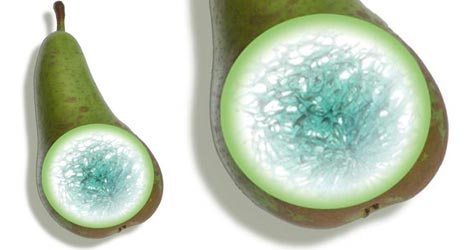Why are pears more fragile than apples during storage?
Pears and apples contain airways that help them 'breathe'. These are small structures that are only visible on a microscope that provides oxygen - an essential ingredient that determines the nature of the fruit.
Scientists from the Leuven Catholic University in Belgium and the European Synchrotron Radiation Facility (ESRF) have for the first time visualized the airways, thus proving their existence. exactly as hypothesis.
For apples, air appears as irregular chambers between cells, while in pears they take the form of tiny internal tubes. The results yielded a deeper understanding of why the fruit spoiled after harvest, and provided a scientific explanation for the daily experience that pears are more susceptible to damage during storage. .
Apples and pears continue to "breathe" after picking. Keeping the fruit always fresh requires a minimum amount of oxygen to provide all the cells of the fruit. If not enough oxygen is supplied, the internal browning disorder will appear to cause fruit quality to decrease. That is why fruit should be stored in a dedicated cooling room with an accurate controlled oxygen ratio. Accurate oxygen levels are related to the mechanisms of gas exchange, respiration and complex fermentation of fruits.

An image of a pear and its internal structure consists of its airways.(Photo: P. Verboven)
Gas exchange is limited, making the oxygen rate too low inside the cells. Three-dimensional images of the microstructure of fruit will help identify and explain the rate of gas exchange and when fruit cells start to die and browning. Getting such images is not easy because fruits contain lots of water, and the resolution and contrast of conventional 3D medicine scanners is not enough.
The Leuven group used the European synchrotron radioactivity laboratory at Grenoble to produce optical images of fruit samples. According to the researchers' findings on the latest issue of Plant Physiology, the effective device produces 3D images that are accurate to 1/1000 of a millimeter with adequate contrast to help distinguish spaces from cells. Images are used in computer models to calculate oxygen levels in each cell of fruit tissue.
Pieter Verboven of the Catholic University of Leuven and author of the article said: 'We still do not know how the airways formed in the fruit, why the apple has a cavity structure while dragging back. have micro tube network '.
However, the results help explain why pears are easily damaged during storage.'The microtubules are so small that the supply of oxygen to the center of the fruit is limited, the cells quickly' suffocate 'when the oxygen ratio drops below the safe level.'
- The reason you should eat pears daily
- Apples are extremely good for health but not everyone knows how to eat properly
- Each apple contains up to 100 million beneficial bacteria for health
- Honeycrisp - One of the most delicious apples in the world
- Pastoral Department 'miraculous apple' 4 years without rot, not broken
- Surprising benefits of green apples
- Fresh crispy apples for months
- Italy: Making paper from apples
- It took 20 years to grow a new generation of red apples
- Eating 'white' vegetables and fruits can avoid stroke
- Why does the cut apple turn brown?
- Why on the apple shell or pear or tiny dots appear?
 'Fine laughs' - Scary and painful torture in ancient times
'Fine laughs' - Scary and painful torture in ancient times The sequence of numbers 142857 of the Egyptian pyramids is known as the strangest number in the world - Why?
The sequence of numbers 142857 of the Egyptian pyramids is known as the strangest number in the world - Why? History of the iron
History of the iron What is alum?
What is alum?